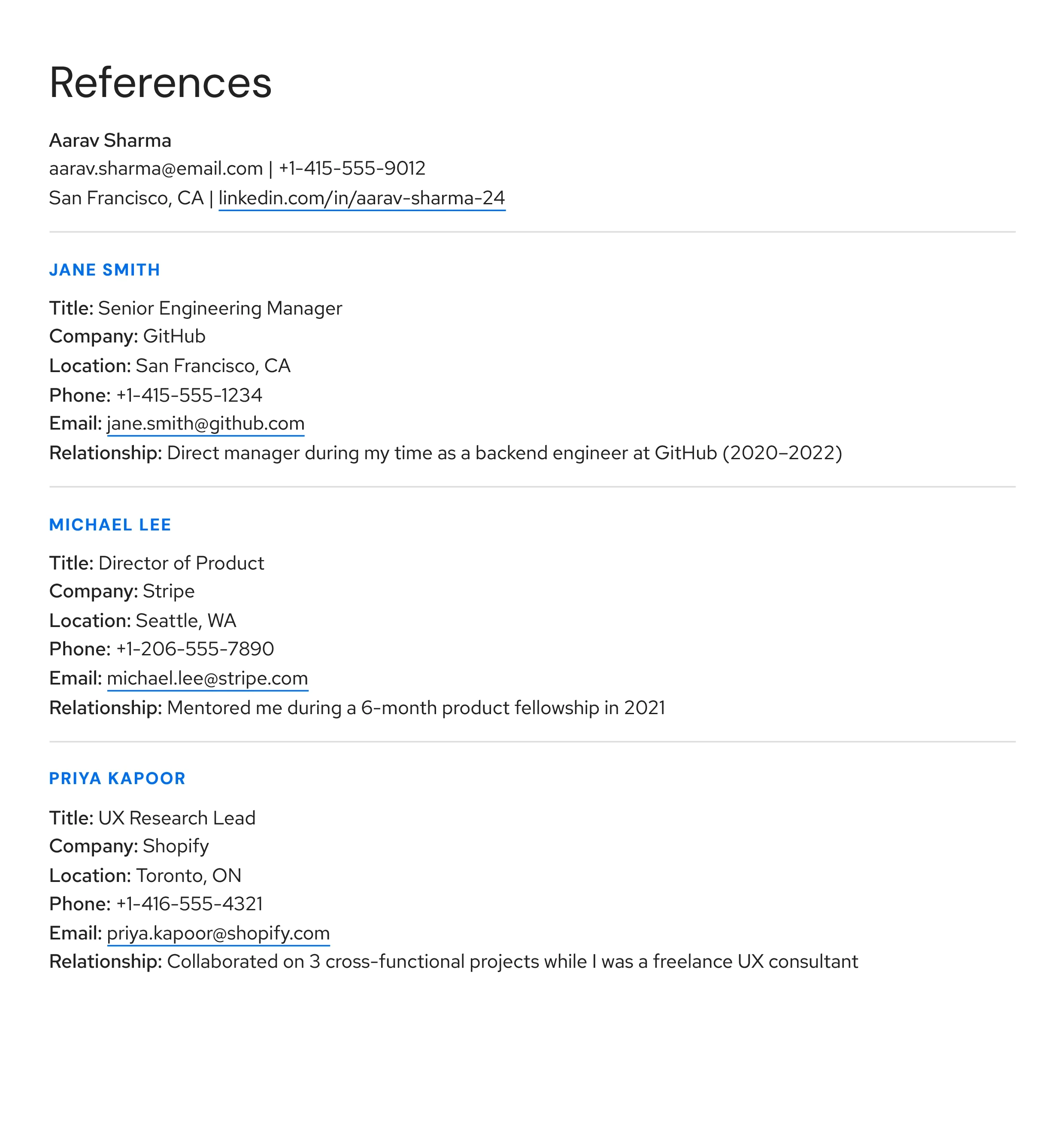You’ve finished your resume. Now comes the confusing part: how to list references on resumes.
Do you include them directly? Just say "References available upon request"? Or skip them entirely?
Let’s walk through exactly how to put references on resume (or rather, how not to), when to share them, and what the best practices look like in today’s job market, especially in tech.
Should resume have references?
No, you should not put references on your resume.
Unless a job description specifically asks for it, references do not belong there.
Here’s why:
- They take up valuable space
- Recruiters don’t need them during the first screening
- They don’t help you get shortlisted
- They expose private information without consent
You want your resume to highlight your skills, experience, and value. References come later, when you're closer to landing the job.
Do references go on a resume at all?
No. Instead of squeezing them in, create a separate reference page for your resume. We’ll show you how below.
Most recruiters will ask for references (if at all) after the interview process, not before. So it’s better to keep them ready, not listed.
If you're wondering how to include references on a resume, the answer is simple: you don't. But you do need a clean, separate reference sheet.
How to create a reference page for resume
A resume reference page is a standalone document. It matches the style of your resume but only includes your references.
Here’s how to make a reference page for your resume:
1. Match your resume format
Use the same header (name, contact info, font) as your resume. Not sure what fonts work best? Here’s our guide to the best resume fonts to use.
2. Include these details for each reference
- Full name
- Job title
- Company name
- Phone number and email
- Your relationship to them
- (Optional) A short note like “Former manager at GitHub”
3. List 2–3 references
Wondering how many references to include on a resume? Two to three is ideal. Some senior roles may need more.
4. Save it as a PDF
Name it clearly: Firstname-Lastname-References.pdf
You don’t need to upload it unless asked. But when that time comes, you’ll be ready.
Markdown template for references:
# References
**Aarav Sharma**
aarav.sharma@email.com | +1-415-555-9012
San Francisco, CA | linkedin.com/in/aarav-sharma-24
---
## Jane Smith
**Title:** Senior Engineering Manager
**Company:** GitHub
**Location:** San Francisco, CA
**Phone:** +1-415-555-1234
**Email:** jane.smith@github.com
**Relationship:** Direct manager during my time as a backend engineer at GitHub (2020–2022)
---
## Michael Lee
**Title:** Director of Product
**Company:** Stripe
**Location:** Seattle, WA
**Phone:** +1-206-555-7890
**Email:** michael.lee@stripe.com
**Relationship:** Mentored me during a 6-month product fellowship in 2021
---
## Priya Kapoor
**Title:** UX Research Lead
**Company:** Shopify
**Location:** Toronto, ON
**Phone:** +1-416-555-4321
**Email:** priya.kapoor@shopify.com
**Relationship:** Collaborated on 3 cross-functional projects while I was a freelance UX consultant
---
## Optional tips (delete before sending)
- Double-check each reference is okay with being listed
- Keep the formatting consistent with your resume
- Save as `Firstname-Lastname-References.pdf`
Here's what the list of references would look like if you converted Markdown to PDF on Resumey.Pro:
 Keep your reference sheet separate from your resume. Use matching headers but different content.
Keep your reference sheet separate from your resume. Use matching headers but different content.
How to include references on a resume if you really want to
Let’s say you have a strong reference or referral and want the recruiter to know about it.
You still shouldn’t add it on your resume. Instead:
- Mention referrals in your cover letter or email
Example: “I learned about this role from Jane Smith, who I worked with at Meta.” - Use testimonials on your portfolio website, with permission
- Link to your LinkedIn, where endorsements and recommendations are visible
This way, you're showing credibility without cluttering your resume or worrying about how long your resume should be.
Should resumes have references in 2025?
Still no. Here’s what you should avoid:
- Listing references directly on the resume
- Writing “References available upon request”. This is outdated
- Copy-pasting full contact info without permission
Can you put references on a resume? Technically yes, but it’s almost always a bad move.
Quick checklist: when to share references
Only share your resume references when:
- A job posting specifically asks for it
- You’re in final interview rounds
- A recruiter or hiring manager explicitly requests it
- You’re working with a recruiter who needs it for submission
Summary: how to list references for resume (the right way)
Here’s the short version:
- Don’t include references on your resume
- Create a separate reference sheet
- Only send it when asked
- Mention referrals in your cover letter or email, not on your resume
- Keep your references informed and get their permission first
By following this approach, you’ll look more professional and protect both your space and your credibility.
Want to build a modern resume that works in tech?
Try our Markdown resume builder that helps you create, manage, and export resumes that recruiters actually read.
